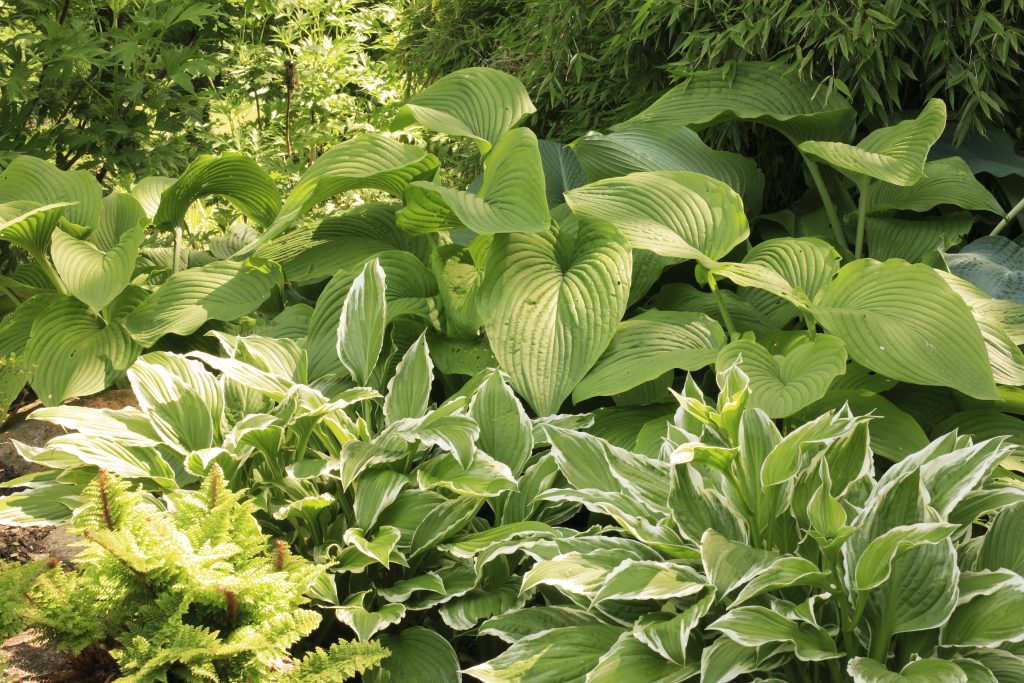
Hosta, also known as plantain lily, is ubiquitous in shady garden areas, and for good reason. The name Hosta refers to the genus of about 70 different species of herbaceous perennials, native to northeast Asia, that are most often cultivated as shade-tolerant foliage plants. Generally, hostas are rhizomatous, clump forming plants with spikes of small, drooping, funnel-shaped, lily-like flowers. There are over 3000 cultivars of hostas with tremendous variety in leaf shape, size, texture and color. The leaves can vary from gold to dark green to blue-green, as well as variegated forms. Leaves may be rounded, oval, heart shaped or strap-like. Hostas bloom in early summer to late fall depending on species and cultivar and flowers can be white, lavender or purple. Some hosta even have fragrant blooms, and hummingbirds and other pollinators love the flowers. The plants range in size from miniature to giant and everything in between. Hostas are versatile, reliable, easy to grow, long-lived, and come in a variety of sizes, shapes and colors to suit most applications.

Soil
Hostas prefer rich, well-drained soil with consistent moisture. Prior to planting, it is best to amend soil with organic material, such as compost, which help the soil retain water.
Fertilizer
Add a layer of organic compost to the soil in spring. Alternatively, apply a well-balanced organic fertilizer when plants begin to come up. Additional applications of fertilizer during the growing season are not necessary.
Water
Water as needed to keep soil moist but not wet. Do not allow soil to dry out and be sure to water during drought. Water at base of plant, beneath leaves, as wet foliage can attract slugs. Mulch around plants to maintain moisture. Hostas planted under shade trees need to be watered regularly because trees will compete with your plants for water. In general, once established, the larger the hosta, the more drought tolerant it will be.
Sun
Although hostas are famous for being a true shade garden plant, they will not thrive in dark, dense shade. Some cultivars are more sun-tolerant but all do best with afternoon shade. As a rule of thumb, the lighter the foliage color, the more sun the plant can tolerate. Those with dark green or blue foliage require more shade and variegated plants will need some sun to help retain their variegation. All hostas need some shade and almost none will thrive with full sun.
Location
Plant in shade gardens with ferns and other shade perennials on the north side of your house. Excellent in sun dappled woodland gardens. They make great accent plants for a shaded area of your shrub border or massed under trees. Hostas also work well in container plantings.

Transplanting/Dividing
While there is no need to divide hostas, if they have outgrown their space, you may want to consider it. Your overgrown hostas are also great for sharing with friends and neighbors! Divide or transplant hostas in early spring when the plant is just beginning to leaf out, or in the fall, after a period of moist, cool weather. If the soil is dry, make sure to water the area thoroughly one day prior to dividing. Start by digging around the hosta clump in a circle, then use your shovel as a lever to lift the clump out of the ground. Cut apart the clump into divisions of at least three sets of shoots and transplant. If you simply want to share your hosta with a friend, you can dig out and cut a few eyes from the outermost edge. Always thoroughly water after transplanting or dividing your hostas.
Pro Tip: Dividing hostas can set them back several years in maturity and they can be slow to recover. If you do want to divide, cut out a portion of the plant’s root mass from the back so that it will not show. The hostas will look the same and you will have hostas to plant elsewhere or give away to friends and neighbors.
Problems
Hostas are extremely hardy and easy to grow and have minimal pest problems.
Slugs are probably the most common problem. Rabbits are known to enjoy the young stems and leaves. Deer can quickly defoliate hostas. There are many products on the market to trap and kill slugs, and to deter rabbits and deer.
It is extremely uncommon for hostas to be plagued by fungal, nematode or viral disease. If you are having issues with your hostas, please send us a photo or bring in a leaf and we would be happy to help you identify and solve the issue.
Our plant library is a great resource for researching various cultivars of hostas.







